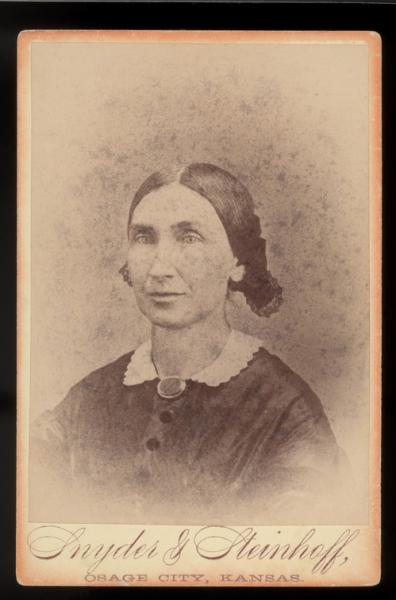By Deborah Keating, University of Missouri-Kansas City
Biographical Information:
- Date of Birth: May 19, 1816
- Place of Birth: Hudson, Ohio
- Claim to Fame: Pioneer, missionary, abolitionist, half-sister of John Brown
- Political Affiliations: Free-State Party
- Date of Death: February 6, 1865
- Place of Death: Leavenworth, Kansas
- Final Resting Place: Greenwood Cemetery, Leavenworth, Kansas
As the violence between Free-State and proslavery factions increased along the Missouri-Kansas border, one family placed itself in the vortex of the conflict. Florella Brown Adair and her husband, Samuel Lyle Adair moved to the Kansas Territory from Ohio as missionaries of the Congregationalist Christian Church. Passionate abolitionists in their own right, Florella’s half-brother, John Brown, would involve her family in the border violence in ways that the Adairs had not anticipated.
Florella Brown was born in Hudson, Ohio on May 19, 1816. Her father, Owen Brown (who was also the father of John Brown by his first wife, Ruth Mills Brown) was associated with Oberlin College, which was renowned not only for its abolitionist doctrine, but also as the first college to regularly admit African Americans and women. He also helped found the Western Reserve College, the Oberlin Church (“Free Church”) and the Western Reserve Anti-Slavery Society, all of which were abolitionist organizations. Thus Florella and her siblings, including her half-brother, John, were immersed in abolitionist sentiment from their earliest memory.
Florella Brown married Samuel Lyle Adair on November 27, 1841, after graduating from Oberlin College. Samuel Adair, who was born April 22, 1811, in Ross County, Ohio to George and Margaret Ramsey Adair, was educated at Western Reserve College and received his ministerial degree from Oberlin. After serving in various ministries in Ohio, Samuel Adair asked the American Missionary Society to send him to Kansas Territory. His desire was not only to bring Christianity to the Plains, but also to work with the abolitionists in Kansas to ensure the territory’s entry into the Union as a free state. Originally reluctant to leave her family and the safety of Ohio, Florella eventually agreed to the move.
In Osawatomie, Florella led the life of a pioneer woman, fighting to establish a home and raise her children.
The Adairs and their children arrived in Kansas City in October, 1854. Eventually they settled in Osawatomie, Kansas, in what is now Miami County. In Osawatomie, Florella led the life of a pioneer woman, fighting to establish a home and raise her children (only three of seven survived to adulthood). She supported her husband’s ambition to establish a church on the edge of the frontier, and she took in sewing and laundry to help support the family while Samuel built his church and congregation.
John Brown’s militant activities began after he moved to Miami County, Kansas, to join his five sons in 1855. The record is vague as to the degree of the Adairs’ participation in Brown’s violence against proslavery settlers, but the Adairs were certainly involved in helping to arrange funding for his activities. Florella and Samuel were clearly aware of his movements and sympathetic with his goals—if not his means—and at least occasionally allowed their home to be used by Brown and his men for meetings and layovers.
When the body of John Brown’s son, Frederick, was found lying near the Adairs’ cabin in the early morning of August 30, 1856, Samuel immediately understood that the proslavery factions were about to attack Osawatomie. He sent his own son, Charles, to warn John Brown and his men of the threat. Adair’s warning came just in time for Brown to escape as a proslavery group, led by John William Reid, descended on Osawatomie and sacked the town. In danger himself, Adair hid in the nearby fields.
When the proslavery men arrived at the Adair home in search of John Brown, Florella stood firmly at the door, insisting that her half-brother was not there.
Meanwhile, Florella, who was seven months pregnant, remained busy at home, caring for a group of sick women and children who fled the carnage and sought shelter at the Adair’s cabin on the outskirts of town. When the proslavery men arrived at the Adair home in search of John Brown, Florella stood firmly at the door, insisting that her half-brother was not there. She offered to allow the leader of the group to search the house if he would. Claiming to be a “gentleman,” the leader declined and prevented his men from burning it in deference to the women and children inside.
Florella and Samuel Adair continued their ministry in Kansas and celebrated the admission of the territory into the Union as a free state in January 1861. With the advent of the Civil War, Samuel Adair joined the Union Army as a chaplain, while Florella remained in Osawatomie with the children. Florella Brown Adair died in Leavenworth, Kansas, on February 6, 1865, but she lived long enough to witness the Emancipation Proclamation and anticipate the end of the war and the eventual freedom of all slaves. Her courage during one of Missouri’s and Kansas’s most violent eras exemplifies not only the courage and fortitude of pioneer women but the moral strength of Kansas abolitionists in the days of the border wars.
Suggested Reading:
Blackmar, Frank W., ed. Kansas: A Cyclopedia of State History, Embracing Events, Institutions, Industries, Counties, Cities, Towns, Prominent Persons, Etc; 3 Volumes; Chicago: Standard Publishing Co., 1912.
Kansas Historical Society. "Samuel Lyle Adair and Florella Brown Adair Family Collection, 1831-1921." Microfilm rolls MS 1230-1237. Manuscript Collection No. 161.
Peterson, Merrill D. John Brown: The Legend Revisited. Charlottesville: University of Virginia Press, 2002.
Cite This Page:
Keating, Deborah. "Adair, Florella Brown" Civil War on the Western Border: The Missouri-Kansas Conflict, 1854-1865. The Kansas City Public Library. Accessed Wednesday, April 17, 2024 - 23:26 at https://civilwaronthewesternborder.org/encyclopedia/adair-florella-brown


